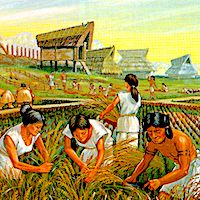

Tao Te Ching
The Power of Goodness, the Wisdom Beyond Words

Agricultural Revolution (10500 – 4000 BCE)
After c. 2.5 million years of hunting and gathering, humans began the Neolithic, the Agricultural Revolution. Animals, wheat, rice, corn, potatoes, barley and millet became domesticated creating huge changes in culture and the creating of what we call civilization. This revolutionary transition began very slowly and—in some ways—continues today. Agriculture dramatically increased populations but also weaker the physical and mental toughness of communities making them vulnerable to the hunter-gatherer remnants surrounding them and now called "barbarians." This created an often-repeated pattern of the more wild and aggressive nomads becoming stronger, attacking the settled peoples, taking over, and becoming the kings and aristocracy. They in turn succumb to the weakening forces of civilization's comforts, luxury, and another more barbaric but stronger wave of conquerors. These "barbarians" became today's political, religious, corporate leaders, the "1%."
The rest became the middle, the lower, the working classes. With historic irony, women began agriculture while the men were out hunting but then, because of it, lost their dominance with the shift from matriarch to patriarchy brought about by the new demands of settling in one place. This irony extended far beyond the war-of-the-sexes power shift as populations grew exponentially while the conditions they lived under rapidly deteriorated.
From the perspective of materialistic progress, the Agricultural Revolution was a great leap forward. From the point of view of diversity—plant and animal life, individual freedom and happiness—it can easily be characterized as a disaster.
The rest became the middle, the lower, the working classes. With historic irony, women began agriculture while the men were out hunting but then, because of it, lost their dominance with the shift from matriarch to patriarchy brought about by the new demands of settling in one place. This irony extended far beyond the war-of-the-sexes power shift as populations grew exponentially while the conditions they lived under rapidly deteriorated.
From the perspective of materialistic progress, the Agricultural Revolution was a great leap forward. From the point of view of diversity—plant and animal life, individual freedom and happiness—it can easily be characterized as a disaster.
Sages
We currently have no authors from this era. Suggest one!
Quotes (1 Quotes)

“The Agricultural Revolution was a trap... This is the essence of the Agricultural Revolution: the ability to keep more people alive under worse conditions.”
Themes: Revolution
Comments: Click to comment
Western Eras
Agricultural Revolution (10500 – 4000 BCE)
Sumerian (Mesopotamia) Civilization (4400 – 3100 BCE)
Egyptian Civilization (3150 – 305 BCE)
Babylonian Civilization (1895 – 619 BCE)
The Axial Age, “The Great Leap of Being” (800 – 200 BCE)
Greek Civilization (480 – 146 BCE)
Roman Civilization (100 BCE – 395 CE)
Early Middle Ages (566 – 1095 CE)
High Middle Ages (1095 – 1304 CE)
The Age of Reason: The Enlightenment (1620 – 1800 CE)
Post-Romantic Age (1850 – 2018 CE)
American Civil War (1861 – 1865 CE)
Comments (0)